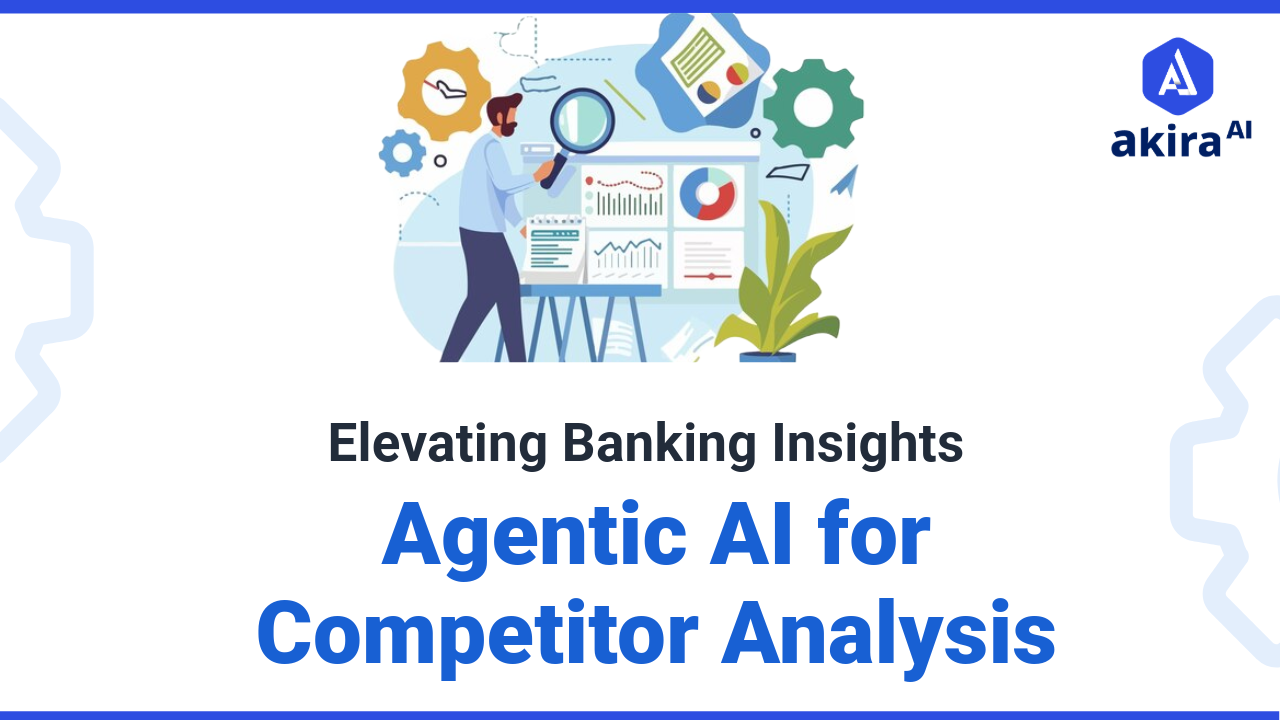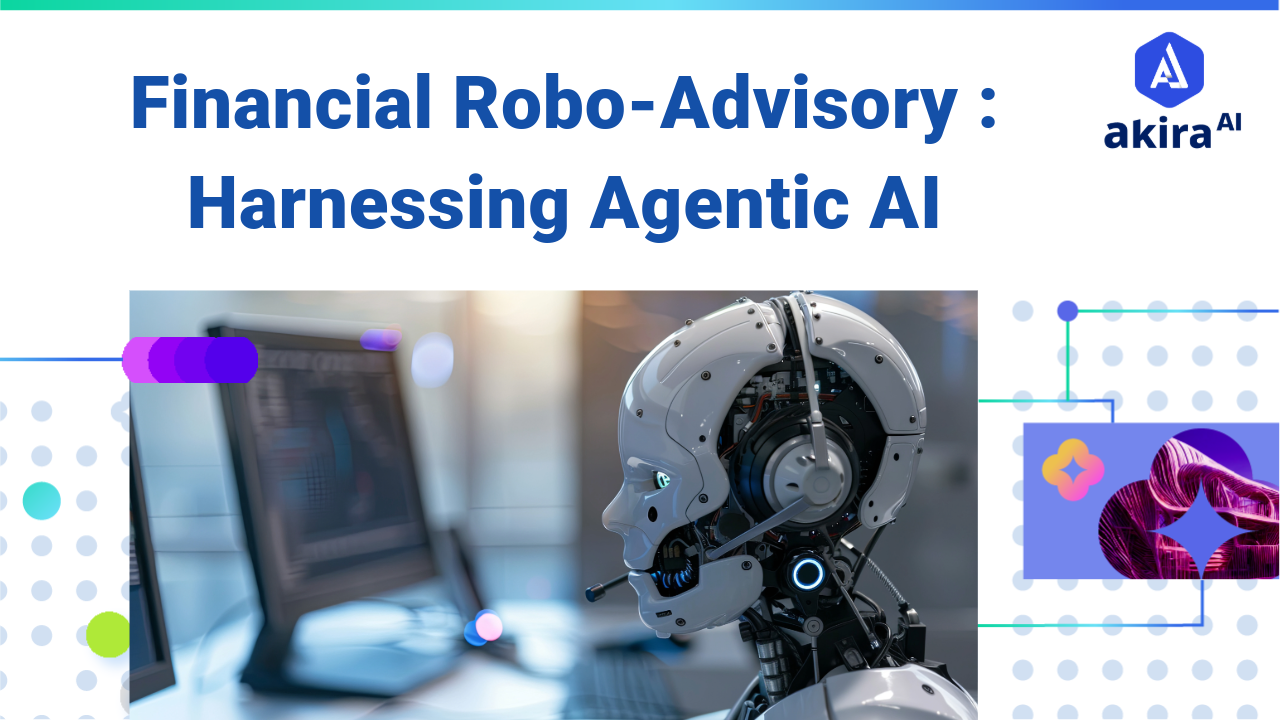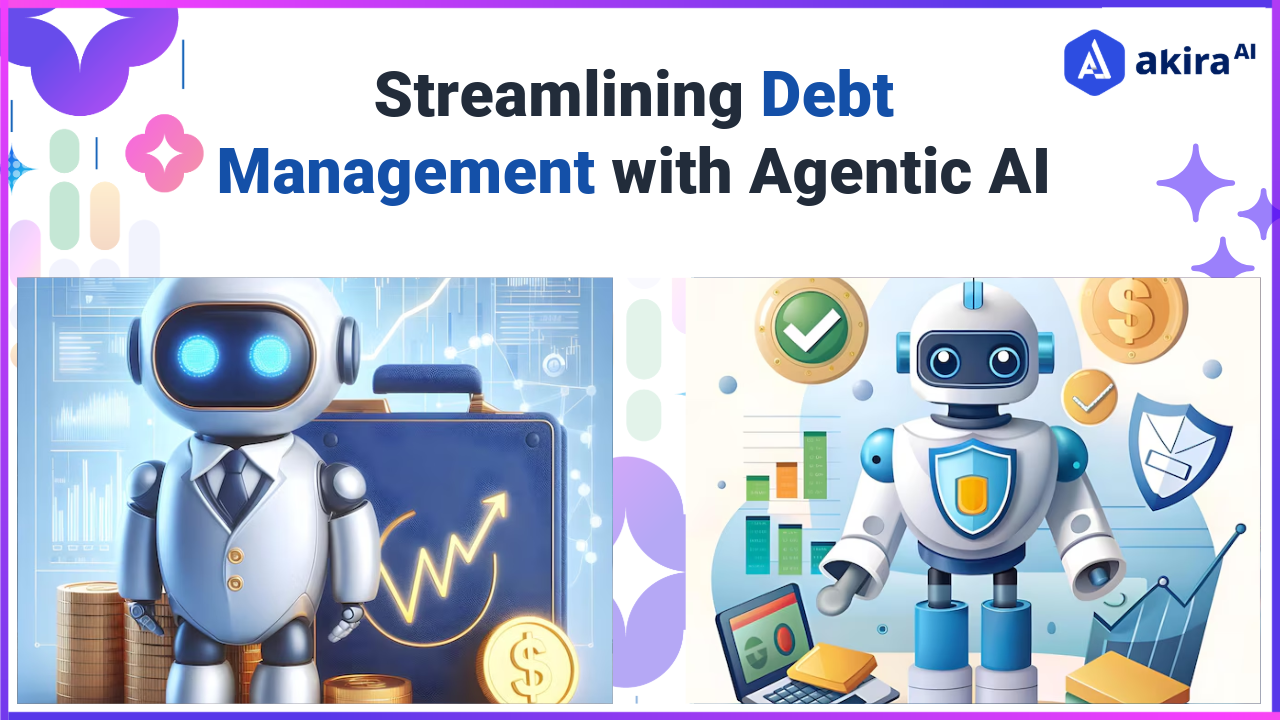Key Insights
The integration of agentic AI in banking chatbots and virtual assistants is revolutionizing customer service. Through multi-agent systems and agentic workflows, these AI solutions enable personalized, seamless, and efficient interactions at scale, automating routine tasks and handling complex functions like fraud detection and loan applications. This shift is setting new standards for hyper-personalized, autonomous, and continuously improving banking experiences.
In today's rapidly evolving customer service landscape, AI agents for chatbots and virtual assistants are revolutionizing how businesses, particularly in the banking sector, interact with clients. By harnessing the power of agentic AI, agentic workflows, and multi-agent systems, these advanced tools enable autonomous, seamless operations, significantly enhancing customer experiences. This blog explores the transformative impact of AI agents in chatbots and virtual assistants, contrasting traditional approaches with cutting-edge solutions, and highlighting the key benefits and optimizations offered by Akira AI's platform.
Chatbot And Virtual Assistant in Banking
This is a type of software entity created to manage the customer interface through automatic yet smart conversations. In its implementation, NLP and ML-based software with sophisticated decision-making features will make use of this agent for ascertaining user queries, resolving problems, along delivering customized support. They have played a great role in the banks serving a wide variety of customer services from some account-related requests to loan applications, and even service that builds in more efficiency and improves upon customer satisfaction.
A Brief Overview of Chatbot and Virtual Assistant
An AI agent is an independent software entity that acts and chooses entirely on its own by utilizing real-time data, machine learning, or even complex algorithms. These agents may be learning about their environment and experiences so that they can optimize their choices and activities in an unsupervised manner. Be it complex workflow management or dynamic change based on data insights; AI agents bring back the future of autonomous operations in any industry. Their ability to work independently gives them a gigantic edge for high efficiency, precision, and adaptability of tasks.
Applied to chatbots and other virtual assistants, AI agents push customer service further beyond simply automating the most straightforward interactions. It is no longer the domain of just answering or responding to routine questions but is now developed, to autonomously manage complex interactions-just like every other system agentic workflows-automated sequences of actions-and multi-agent systems-to efficiently deliver personalized customer experiences. For example, in banking, AI agents are used in chatbots, and virtual assistants can monitor such tasks as fraud detection and onboarding of clients for loan application processes. This would allow for smooth, data-driven interactions across various platforms with smarter, faster, and intuitive customer service solutions.
Traditional Practices vs. Agentic AI Solutions
|
Aspect |
Traditional Practices |
Agentic AI Solutions |
|
Technology |
Static chatbots or rule-based virtual assistants |
AI agents powered by machine learning and real-time data |
|
Response Mechanism |
Predefined, limited responses |
Dynamic, personalized responses based on real-time data |
|
Context Understanding |
Limited ability to understand user intent and context |
Advanced context understanding and intent recognition |
|
Learning Capability |
No learning or adaptation from interactions |
Continuous learning and adapting based on interactions |
|
Task Handling |
Simple, repetitive tasks |
Complex tasks, such as financial history tracking and product recommendations |
|
Customer Experience |
Frustration due to limited capabilities and rigid responses |
Personalized and seamless customer experiences |
|
Efficiency |
Manual intervention is required for complex issues |
Autonomous operations with agentic workflows |
|
Operational Scope |
Limited to specific, rule-based queries |
Expanded operational scope, handling multifaceted customer service tasks |
|
Scalability |
Difficult to scale without significant reprogramming |
Easily scalable across multiple platforms and channels |
How do AI Agents Improve Chatbots and Virtual Assistants?
AI agents bring and expand the capabilities of these chatbots and virtual assistants into much smarter, adaptive, and capable agents than the traditional systems. Here's how it drives those improvements:
-
Enhanced Personalization: These robots can analyze not only the current interaction with the user but also historical data, and therefore make recommendations or responses tailored for each user. Therefore, this level of customization makes chatbots different from mere information providers because they are value-added customer service tools that understand individual preferences and needs.
-
Flexibility: AI agents, through multi-agent systems, process a large amount of data on the fly. This enables them to adapt dynamically to changes in conversations and thus provide the most accurate possible answer to an issue raised by the customer. It enables the AI agents to respond to customer queries on a new service or alert about anomaly in customer's account activity on the fly.
-
Continuous Learning: It is a good feature because, unlike a traditional static system, AI agents learn from every interaction. They continue to refine their models in real-time with feedback and previous experience so the better it will predict customer needs and understand intent over time. In this manner, with each engagement, the chatbot or virtual assistant will be smarter and more effective.
-
Handling complex tasks effectively: AI agents reduced the response time by automating complex tasks like resolving technical problems or clearing financial transactions. Because of the reduction in query handling tasks, human agents are freed to do other necessary high-value tasks. This implies that there is an improvement in efficiency in operating.
-
Autonomous Operations: AI agents enable independent functionality of the chatbots and virtual assistants without the need for human over-the-shoulder supervision. This is especially important to ensure business continuity by offering, for example, round-the-clock customer support on diverse tasks, from small customer questions to high-level financial advice.
Applications of AI agents in chatbots and virtual assistants
.png?width=1280&height=720&name=Blogs%20Images-2(2).png)
Fig 1: Use Cases in Chatbot & Virtual Assistant
AI agents have demonstrated their competence in numerous fields, but primarily in the banking and finance sectors.
-
Fraud Detection: AI agents scan all transactions in real time for any possible suspicious activities. Any anomalies can be communicated promptly to the customers and in some instances evaded preventively by blocking temporarily an account or flagging a transaction for review, thus reducing financial risk and intervention in time for malpractice.
-
Loan Application Support: Virtual Assistants AI Guides the users through the process of loan application by answering questions, gathering information, and recommending the best loan options. It can even analyze a user's financial profile and thus help in developing the most suitable types of loans and interest rates, making it quicker and user-friendly.
-
Account Management: Through AI-powered chatbots, the customers would be able to check their balance, know transaction history, schedule regular payments, and thereby solve debit/credit card-related issues. These bots would work 24/7, thereby ensuring that with every question the customers would raise, they would receive solutions in real-time, without requiring referring to human beings.
-
Investment advice: Based on the financial position of the customer, level of investment, and each user's capacity for risk, AI agents offer individually tailored investment advice. For instance, an AI virtual assistant may present real-time data analysis for a customer of the market conditions and hence provide recommendations for portfolio changes in such conditions.
-
Virtual assistants powered by AI can handle a large category of customer queries ranging from simple FAQs to more sophisticated demands. It can work single-handedly in answering straightforward queries while taking the more complex and sophisticated issues to human representatives context-aware, therefore lowering wait time and overall service quality.
-
AI Agent Automated KYC Process Using AI Agents, the KYC process is completed by gathering and verifying customers' documentation using chatbots. It can check ID proofs against regulatory databases and flag any discrepancy so that the occurrence of manual labor there may be significantly reduced along with ascertaining legal standards compliance.
-
Credit Card Management: Users can select, and in fact, apply for new credit cards using the AI-powered virtual assistant, which can also turn their cards on or off. Further, the device can send users notifications of upcoming due dates for payments or suspicious activity related to their credit card accounts.
-
Wealth Management: AI agents will indeed assist wealth management consultants in analyzing their client's data and then present them with other investment options or financial strategies. It can also create personalized self-driven investment reports and recommendations on a client's financial history and risk tolerance.
-
Transaction Dispute Resolution: Through AI agents, customers will raise disputes concerning unauthorized or incorrect transactions. The AI agents will retrieve the relevant data quickly and analyze them to answer the dispute or escalate it to human representatives for resolution. This therefore reduces the period involved in dispute resolution to enhance satisfaction with a customer.
-
Insurance Claims Processing: AI virtual assistants in the insurance business accept claims through receipt of documentation done through AI, validating claims through AI-led checks to report on the status of the claim. This will make claims processing easy for customers with better visibility.
Akira AI's Multi-Agent Solution
-
Intent Recognition Agent: This agent, autonomously, gets the intention of the user from his inputs. It is a key constituent in the workflow that represents an agency: it identifies the purpose behind each interaction and ensures a relevant set of agents takes relevant actions. Through multi-agent systems, it can harmoniously coordinate with other agents, such as the entity extraction agent, in fine-tuning user requirements. Since it is an autonomous agent, decisions occur in real-time without the presence of humans, hence it promotes quality interactions.
-
Entity Extraction Agent: An extraction agent mainly self-detects that are mainly significant; for example, names or amounts, in any input with which a user may provide. This is one of the basic features of agentic AI workflow systems: it takes relevant information flowing into a workflow because of a user's queries, feeds that into other agents for them to process it, and produces even more accurate and context-driven responses while acting independently within a multi-agent system for task streamlining processes.
-
Dialogue Management Agent: It coordinates all flows for conversations so that interactions for the users become seamless and sensible. Being an important component in autonomous operations, it dynamically adjusts the dialogue by taking inputs from the users so that the conversation makes sense as a coherent stream. This flows into interaction with an intent-identification agent and a sentiment analysis agent to ensure workflow runs well for agentic operations, thereby deciding in real-time as the agentic arrangement needs readjustment.
-
Agent Sentiment Analysis: Because it autonomously gauges the emotional tone of user inputs, this would ultimately enhance the agent's capability to provide more emotionally charged responses. This goes well into agentic AI interpretation of a user's emotional state being used to inform more tailored and personalized responses. It fits well into the multi-agent system by adjusting an overall conversation strategy better to satisfy users and runs independently without requiring any need for manual intervention.
-
Product Recommendation Agent: Through other agent data, which includes identifying intent and sentiment analysis, it comes up with products or services that match the user's need automatically. The agentic workflows ensure that the recommendations become contextual and specific. Such an aspect builds engagement and satisfaction. With the operation of autonomy within a multi-agent system, it does make real-time product suggestions for the customer's journey.
-
Transaction Processing Agent: The transaction processing agent encompasses each step of purchasing or finishing a transaction without any kind of human interface. This agent will offer safe and fast processing by making several pieces of data to confirm and finalize purchases. The system is an agentic AI and integrates automatically to complete a transaction without the need for human intervention, thus ensuring operational smoothness and efficiency in the workflow.
-
Final Output: This is the final output produced at the end after a well-coordinated multi-agent system operating through the agentic workflow. These agents contribute autonomously, thus ensuring that the whole process, from understanding the user's intent to finalizing a transaction, is made seamless, thereby providing a superior experience for the user.
Benefits of Chatbot and Virtual Assistant in Banking
-
Efficiency Coefficient: With AI agents automating routine tasks, banks process volumes of customer inquiries. In general, this automation enables human agents to focus on more complex issues, which enhances organizational operational efficiency.
-
Cost Savings: The banks can utilize the conserved resources much better for reinvestment in technology and services by leaning less on human staff for basic inquiries, thereby significantly reducing reliance on human staff for basic inquiries.
-
Improve Customer Experience: While data-mining individualized customer information, AI agents provide faster, more personalized interactions where the clients have higher satisfaction and loyalty because they receive customized responses and timely assistance.
-
Available 24/7: AI agents provide round-the-clock support, allowing customers to access assistance anytime, beyond the bounds of a traditional business hour, thus enhancing service quality and convenience for customers.
-
Data-Driven Insights: By analyzing customer interactions, AI agents generate valuable insights into customer behavior and preferences. These insights enable banks to refine their offerings, tailor marketing strategies, and make informed business decisions to enhance customer engagement.
-
Enhanced Compliance and Security: AI agents can monitor transactions and interactions in real-time, ensuring compliance with regulatory requirements and identifying potential security breaches. This proactive approach enhances the bank’s ability to mitigate risks and protect customer data.
-
Fostering Innovation: The implementation of AI agents encourages a culture of innovation within organizations. By embracing cutting-edge technologies, banks position themselves as industry leaders and attract tech-savvy customers who value modern, efficient services.
The Future of AI Agents for Chatbots and Virtual Assistants
-
Advances in Agentic AI: The future of AI agents is to the continuation of agentic AI advances that lead to more self-governing chatbots and virtual assistants. This brings systems to higher levels that will most likely have much more authority in order to enable the independent execution of such more complex and urgent tasks, like financial planning or risk assessments.
-
Hyper-Personalization: This demand is going to make the scope of AI agents even larger in increasing the interaction with hyper-personalized material through real-time customer data. Innovations in NLP and machine learning will help make these agents capable of understanding and predetermining the needs of the individual customer in the process.
-
Integration of Multi-Agent Systems: The near future would also witness wide proliferation of multi-agent systems, wherein various kinds of AI agents collaborate with each other to solve the customer's problem. Multi-agent systems would also offer better problem-solving capabilities for banks such that complex issues could be addressed quickly while customer experience across channels is intact.
-
Increased Focus on Security: The greater the reliance on AI agents, the more significant the focus would be on security and data privacy. Advanced security protocols for incorporating sensitive financial information will be required so that customers can be protected from scams and related problems while still adhering to rules and regulations.
-
AI-Powered Insights and Analytics: They will make powerful use of analytics tools supported by AI agents revealing insights behind their customers' behaviors and preferences. Use such data for developing products and marketing campaigns for the banks to evolve in the marketplace accordingly.
-
Continuous improvement through learning: The AI agents learn and adapt themselves moment by moment while interplaying with the customers. This continuous self-improvement leads them toward higher accuracy and efficiency in performance, perfecting capabilities over past experiences and customer feedback.
Conclusion: Chatbots and Virtual assistants
Agentic AI-based banking chatbots and virtual assistants change the game in customer interaction as multi-agent systems, agentic workflows, and agentic AI come into play. This brings forth operations that smoothly run with higher-than-ever-before customer satisfaction and operational efficiency levels. These platforms, such as Akira AI, which perfect all of these technologies, will probably herald hyper-personalized scalable banking services with accuracy in the not-too-distant future. This evolution caters to growing consumer demands whilst placing the banks in a highly competitive landscape where they can set excellent standards to customers on delivery of their services.
Transform Your Banking Experience with AI-Driven Solutions



.png?width=1280&height=720&name=Blogs%20Images-3(4).png)



